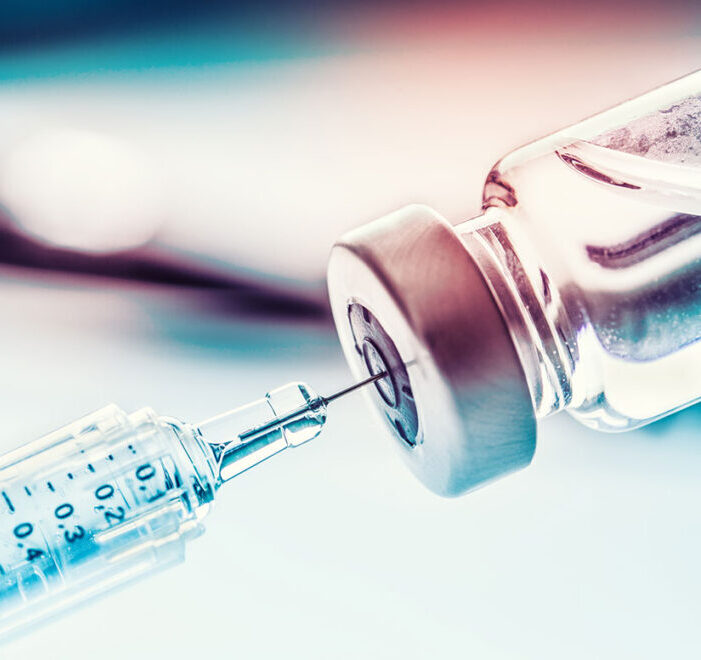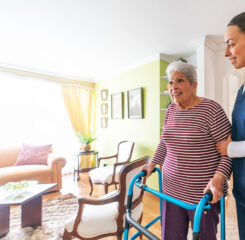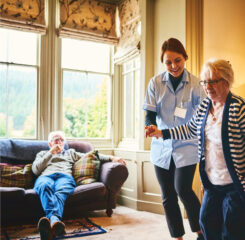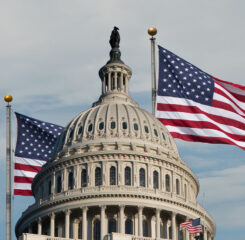The American Rescue Plan and Home and Community-Based Care
The American Rescue Plan is on track to become law by the end of the week.
The Senate updated and passed the American Rescue Plan on March 6, and the House passed the updated bill on March 10. The President is expected to sign the bill into law by March 12.
There were some changes between the initial House bill and what the Senate ultimately passed, and this article is meant to describe provisions in the final package that could lead to increased funding and/or opportunity for home and community-based care providers. This article updates from our article on February 25 detailing the House version of the bill.
Funding for Medicaid Home and Community-Based Services
The final bill includes a one-year, 10 point increase in the federal share of Medicaid spending for home and community-based services (HCBS). The text includes state plan home health and personal care, PACE services, and waiver services (like adult day) as services eligible for this increased federal match.
This is larger than the 7.35 point increased the House bill included, and the 10 point increase will direct about $12 billion to Medicaid HCBS from April 1, 2021-March 31, 2022.
The money will go to state agencies, who would then have discretion over how to use the dollars. Critically, however, the American Rescue Plan requires that states actually use these dollars for their HCBS programs and not for other purposes. Specifically, the text requires states to use the funds to “supplement, and not supplant, the level of State funds expended for home and community-based services for eligible individuals through programs in effect as of April 1, 2021“. Further, states must “enhance, expand, or strengthen” their HCBS programs, but the text does not spell out how the states can/cannot do so.
Because state agencies will determine how these dollars go into the community, it is critical that HCBS providers of all sorts work with their state agencies and closely monitor what their state does with the enhanced federal HCBS dollars.
Other Medicaid Spending
The bill also incentivizes non-expansion states to expand their Medicaid programs by offering a two year, five point increase in the federal share of Medicaid across all services, including the HCBS programs mentioned above. While states would have much more leeway with how to use these dollars, it could provide an important cash infusion that could ultimately support home and community-based care and/or stave off budget cuts.
Older Americans Act COVID-19 Vaccine and Activity Funding
As has been in the case in previous COVID-19 legislation, Older Americans Act (OAA) programs will receive emergency funding under the American Rescue Plan. The Senate text largely mirrors what the House bill included for OAA.
About half of the proposed $1.4 billion would go to senior nutrition programs, and about a half billion dollars would go to supportive services, which can include HCBS. States can also use the half billion dollar allocation for COVID-19 vaccine outreach, education and transportation specific to older adults as well as activities to mitigate the virus itself and its implications for older people, including social isolation.
The Administration for Community Living has disbursed the COVID-19 OAA funds to states using the typical OAA funding formulas. From there, states will determine how to allocate the dollars and to which entities.
While many LeadingAge members do not directly receive OAA dollars, this round of funding may be an important resource toward getting the people our members serve connected to vaccines and ultimately connected back to the community.
State and Local Aid
The American Rescue Plan also includes $350 billion for state and local (city and county) governments. These dollars are separate from and in addition to the CARES Act state and local dollars. The American Rescue Plan offers states and localities more flexibility with how to use the dollars relative to the CARES Act money, and HCBS providers may be able to receive additional relief from this appropriation.
Many states created HCBS-specific and/or broader long-term care relief funds using the CARES Act dollars. While there is no requirement that states/localities do so with any of the COVID-19 relief dollars they received or would under this bill, these dollars may be an avenue through which HCBS providers are able to access direct financial support.
The Senate bill also adds a $10 billion critical infrastructure program to assist state and local governments with “critical capital projects directy enabling work, education, and health monitoring, including remote options”. LeadingAge will monitor how these dollars are used and whether they can go to home and community-based care.
You can view how much money your state, county and locality will receive from these dollars at the file linked here, prepared by Senate Democratic leadership.
Provider Relief Fund
The Senate bill includes an $8.5 billion allocation to the Provider Relief Fund specifically for providers in rural areas. HHS distributes these dollars as they have throughout the pandemic. Importantly, LeadingAge worked with Congress to ensure that the definition of rural provider included those of home and community-based care. The Senate bill defines rural providers to include, among others, “a provider or supplier that furnishes home health, hospice, or long-term services and supports in an individual’s home located in a rural area”. LeadingAge will monitor HHS activity and communicate with members on how to access these dollars.
Paycheck Protection Program
The Paycheck Protection Program (PPP) emerged as an important lifeline for many HCBS providers otherwise not able to receive financial support during the pandemic. While the December relief bill created a second draw loan program and added $284 billion to the PPP fund, the American Rescue Plan makes some additional changes to the program that could expand eligibility to some HCBS providers, particularly those part of larger nonprofit organizations.
Under current PPP rules, most organizations must employ 500 workers or fewer to be eligible, regardless of how many locations they operate. The American Rescue Plan would shift this policy for not-for-profit organizations and allow larger not-for-profit organizations to receive a PPP loan if they have 500 workers or fewer in each physical location they operate.
So for example, a not-for-profit multisite aging services organization that has a nursing home with 300 workers, an adult day services program with 20 workers and a home health agency with 350 workers currently cannot get a PPP loan because it has 670 workers. Under the American Rescue Plan, however, it would be eligible because each of its locations has fewer workers than the limit of 500.
This provision could open the doors to HCBS providers that exist within larger organizations and health systems. First draw PPP loans are based on 2.5x an organization’s monthly payroll, limited to $10 million.
Next Steps
Most of the money that could go to home and community-based care will be distributed at the state and/or local levels. LeadingAge will work with our state partners and members to help ensure that these dollars are best used to support older adults in the community and the providers that serve them.

Most Recommended
October 15, 2025
 Shutdown Week Three: Impact of Ongoing Closure on Affordable Housing
Shutdown Week Three: Impact of Ongoing Closure on Affordable Housing
December 10, 2025
Fiscal Year (FY) Funding 2026
October 07, 2025
Immigrant Workforce Matching Program Brings Workforce Relief
Recently Added
December 29, 2025
 CMS Publishes Draft OASIS-E2 Guidance Manual
CMS Publishes Draft OASIS-E2 Guidance Manual
December 23, 2025
 CMS Debuts Models: ACCESS, ELEVATE and LEAD
CMS Debuts Models: ACCESS, ELEVATE and LEAD
December 22, 2025
GAO Report: Ensuring Accessible Healthcare
December 19, 2025



